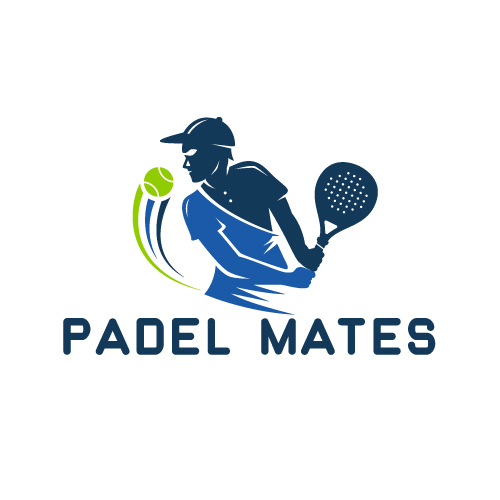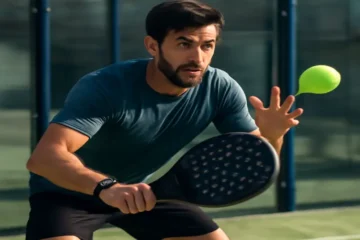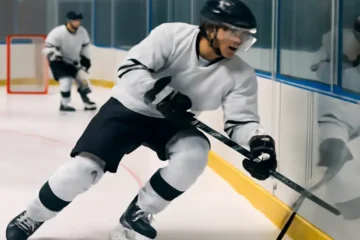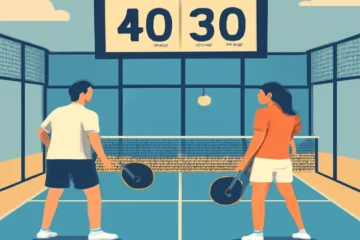Padel is not just a game of reflexes and technique—it’s a mental battle as well. One of the most vital skills that separates amateur players from seasoned ones is the ability to read the opponent’s shots. Knowing what your opponent is about to do gives you the upper hand in every rally, allowing you to anticipate instead of react, positioning yourself effectively to counter any shot.
In this guide, you’ll discover how to decode the visual cues, body language, and patterns that hint at your opponent’s next move. Mastering this skill means fewer surprises, better timing, and ultimately, more wins on the padel court.
Understanding Your Opponent’s Body Language
Racket Position: The Grip and Angle That Reveal Intentions
The first thing to pay attention to is the way your opponent holds their racket. The grip pressure and angle are often early indicators of what’s coming next. A more relaxed grip may signal a drop shot or a lob, whereas a firmer grip often precedes a powerful drive or smash. Watch the angle of the racket face—if it’s slightly open, expect a slice or a soft shot; if it’s closed and positioned lower, a fast-paced flat shot is likely.
Body Stance: Open vs. Closed Positions
Another tell lies in the stance of your opponent just before contact. An open stance—with hips and shoulders facing more toward the net—usually favors cross-court shots or slower tempo plays. In contrast, a closed stance, with the body turned sideways, is often a precursor to more aggressive shots like the vibora or a strong bandeja.
Eye Movement: The Direction of Focus
Though subtle, your opponent’s eyes can betray their plan. Players often glance toward the spot they intend to hit just before the swing. While experienced opponents might try to mask their intention, most players unconsciously telegraph their next move by glancing toward open spaces or weak zones.
Analyzing Shot Preparation
Backswing Length: Telltale Signs of Power or Softness
The length of the backswing is a powerful clue. A short backswing, with minimal arm movement, typically signals a drop shot or a deceptive push. In contrast, a longer, more exaggerated backswing often indicates preparation for a high-impact shot, like a smash or deep drive. Pay close attention to how early your opponent begins this motion—it gives you extra time to adjust your position.
Foot Positioning: The Base of the Shot
Feet often move before the racket does, making them critical in your shot-reading arsenal. If your opponent steps forward into the ball, they’re likely preparing for an aggressive play. If their weight is more neutral or leaning back, it could be a defensive shot or a lob. Side-step positioning may indicate a cross-court shot, especially if they’re trying to create a sharp angle.
Ball Contact Point: Height and Timing
The height at which your opponent contacts the ball greatly influences the type of shot. Contact above shoulder level usually results in overhead smashes or viboras. A waist-level contact is common for groundstrokes, while anything lower near the knees or below could signal a drop shot or a defensive lob. Watch how early they strike the ball after the bounce—quicker contacts usually mean they want to maintain pressure.
Recognizing Common Shot Patterns
Bandeja vs. Vibora: Subtle but Key Differences
The bandeja and víbora are signature overheads in padel, and telling them apart can help you react quicker. The bandeja has a slower, arcing trajectory, used to maintain court control. The víbora, with its side-spin and flatter trajectory, is more offensive. Watch the wrist action—if your opponent adds a slicing motion at the end, they’re likely going for a víbora.
Drop Shots: Deceptive and Silent Killers
Drop shots often come with minimal backswing and a soft wrist movement. Players tend to lean slightly forward and may reduce their grip pressure just before execution. Be suspicious when a player slows their preparation—especially after a series of fast-paced exchanges.
Power Smashes: The Obvious and the Not-So-Obvious
Power smashes are easier to anticipate when you see a coiled body, raised non-dominant arm for balance, and a full backswing. The more time an opponent spends setting up under the ball, especially near the net or after a high lob, the higher the chance of a flat-out smash.
Using the Glass and Walls to Predict Shots
Rebound Clues: Reading the Glass
Walls aren’t just obstacles—they’re mirrors into your opponent’s intention. A ball hit with topspin will rebound differently off the glass than one hit flat or with slice. If a ball hits the back wall and rises sharply, it was likely hit with topspin. A ball that skids low off the side glass could suggest a slice or undercut drive.
Angles and Wall Usage
When players use the side wall before crossing the net, they often aim to pull you off position. Watch for racket position and body alignment; a parallel stance to the glass often indicates a cross-court shot, while a more squared stance may produce a direct drive. Knowing your angles and observing shot tendencies helps anticipate where the rebound will land.
Improving Your Reaction Time
Drills to Boost Anticipation
Regular anticipation drills, such as shadow footwork and reaction ball training, can sharpen your ability to read shots. Pair drills with a coach or partner who mixes in unpredictable shots, forcing you to observe cues in real time.
Practicing the Split Step
The split step is essential in padel—it’s your ready position for explosive movement. Just before your opponent hits the ball, do a slight hop, landing with your weight evenly distributed and knees bent. This sets you up to move quickly in any direction the shot dictates.
Watching the Pros
Nothing beats learning from the best. Study professional padel matches to observe how players anticipate and react. Take notes on how top players read body cues, how they position themselves before the shot, and how rarely they get caught off guard.
Psychological Tactics to Confuse Opponents
Disguising Your Own Shots
Reading shots is a two-way street. To keep your edge, work on disguising your own shots. Use the same stance and backswing for multiple shot types—e.g., a lob and a drive—from the same setup. This forces your opponent to guess, giving you the upper hand.
Fake Movements and Deception
Incorporate fake body movements, like a pretend wind-up for a smash followed by a drop shot. Changing rhythm and adding pauses in your routine can throw off your opponent’s timing and create hesitation.
Common Mistakes When Reading Shots
Overcommitting Too Early
One of the most frequent errors is guessing too soon. It’s tempting to jump the gun, especially when you think you’ve read the shot correctly. But overcommitting leaves you vulnerable to feints or last-second changes. Wait until the opponent initiates the stroke before committing fully.
Ignoring Opponent’s Weaknesses
Players often fall into the trap of reacting the same way to every player. But each opponent has different habits and shot preferences. Pay attention to their tendencies—do they always lob under pressure? Do they favor the cross-court shot? Use this intel to make educated predictions.
Focusing Only on the Ball
While it’s natural to follow the ball, the real story lies in the player’s body and preparation. Don’t get tunnel vision. The ball tells you where it’s going after it’s hit—your job is to read the signs before that happens.
Conclusion
Mastering how to read your opponent’s shots in padel is a game-changer. It enhances your reaction time, improves positioning, and gives you a mental edge that pure technique can’t replace. By studying body language, shot preparation, and court patterns, you turn defense into offense and confusion into confidence.
Like all padel skills, reading shots takes time and practice. Start observing during practice games, analyze your opponents, and study pros to internalize patterns. The more you watch, the more intuitive it becomes—and soon, you’ll be one step ahead on every rally.
FAQs: Reading Your Opponent’s Shots in Padel
1. Why is reading your opponent’s shot important in padel?
Reading your opponent’s shot helps you anticipate their next move, allowing you to position yourself better and react more quickly. It can turn a defensive situation into an offensive opportunity and is a critical skill for winning tight rallies.
2. What are the most common visual cues to look for in padel?
Key visual cues include your opponent’s body stance, racket angle, backswing length, and eye direction. These elements often reveal the intended direction, speed, and type of shot before contact is even made.
3. How can I improve my anticipation skills in padel?
You can improve anticipation by practicing drills focused on reaction time, observing your opponent’s patterns during play, using the split step before each shot, and watching professional matches to learn visual cues and common setups.
4. How do professionals disguise their shots in padel?
Professional players often use the same stance and swing mechanics for multiple shot types to keep opponents guessing. They may also use delayed wrist movements, fake body positioning, and subtle changes in timing to mislead the other team.
5. What’s the difference between a bandeja and a vibora, and how can I tell them apart?
The bandeja is a defensive overhead shot with a higher, controlled arc, while the víbora is a more aggressive, spin-heavy shot with a lower trajectory. The difference is often visible in the wrist movement and racket follow-through.
6. Is it better to focus on the ball or the player when trying to anticipate shots?
Focusing solely on the ball limits your ability to anticipate. Instead, train yourself to observe the opponent’s body language and racket preparation to gain valuable early insights before the shot is hit.
7. Can beginners learn to read shots effectively, or is it an advanced skill?
While it is a more advanced skill, beginners can and should start developing it early. With practice and observation, even newer players can pick up on basic cues like backswing length and stance to predict shots.
8. How do I avoid overcommitting when guessing my opponent’s shot?
Stay on the balls of your feet and use the split step to stay dynamic. Wait for clear cues before fully committing your movement. It’s better to delay a half-second than to be completely out of position due to a wrong guess.
9. Do glass walls help in reading the shot’s direction?
Yes, the rebounds off the back and side glass provide additional information about the spin and direction of the shot. Understanding how different spins affect the bounce can help you anticipate where the ball will go next.
10. What should I do if my opponent is very good at disguising their shots?
If your opponent hides their intentions well, focus on their patterns and tendencies over the course of the match. Take note of which shots they favor in specific situations (e.g., under pressure, at the net, during lobs) and adjust your position accordingly.




